Landing helmets of the German skydivers 1935-1945's
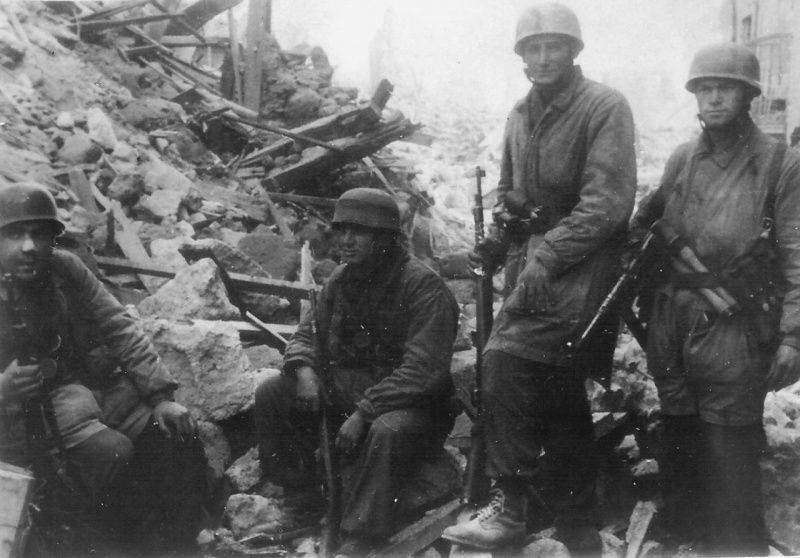
The German military department was interested in the possibility of the combat use of the airborne troops from the mid 30s. The luftwaffe commander himself and the minister became the locomotive for the implementation of their creation plans. aviation Reichsmarschall Goering. The capabilities laid down in the new branch of the armed forces were the best fit for the blitzkrieg concept: carrying out lightning-fast deep offensive operations with a breakthrough into the depth of the enemy's powerful tank wedges. Parachute troops (Fallschirmtruppen - FST) were called in to pave the way for them in accordance with this doctrine. Their task was to quickly capture strategic objects - bridges over which columns of tanks and motorized infantry must pass, fortified areas, communication centers, etc. The famous Kiev exercises of 1935, which were attended by several German military observers, clearly illustrated the theoretical calculations of army specialists and served as an additional impetus to the beginning of the formation of their own airborne forces. We add that the leadership of the Wehrmacht, forced to recreate it practically from scratch, was largely free from inert ideas about the conduct of modern warfare that dominated the military circles of other countries. The formation of parachute units began almost simultaneously both in the ground forces and in the German air force. On October 1, 1935, the personal guard detachment of General G. Goering (Landespolizeigruppe General Goering), who, among other ranks and titles, was the chief of the Prussian land police, was transferred to the Luftwaffe as a separate regiment “General Goering” Around the same time, volunteers from its composition they are sent to the town of Altengrabov, where the formation of a parachute rifle regiment of the Air Force is underway, for special training.
The most expressive and memorable thanks to the flawless plastic of the lines during the first half of the 20th century, remained the helmet of the German soldier - Stahlhelm (steel helmet). The first samples of such helmets were put into service in 1916, received the designation M16.
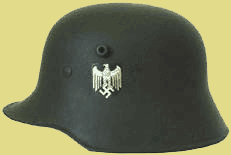
The change in the role of infantry in the war, the increase in its mobility, the rejection of positional battles in which maximum head protection was the main function of the helmet, led to a decrease in the size of the visor and nazatlnikov. The helmet began to stamp from alloyed carbon steel with the addition of molybdenum. Sheet thickness ranged from 1 to 1,15 mm. A helmet made of such steel could withstand pressure up to 220 kg per square mm, which provided protection even from large fragments and pistol bullets. As a result, the German helmet M35 (adopted by the Wehrmacht in 1935) visually became more streamlined and plastic.
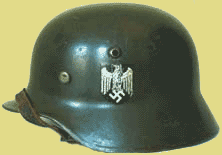
By the beginning of World War II, the German M35 helmet was rightfully considered the best example of protective weapons.
Despite all the advantages, already at the initial stage of training parachutists it turned out that the standard M35 army helmets are unsuitable for use with skydiving. The conical field of the helmet created a swirling airflow that disrupted the helmet from the paratrooper's head, which could lead not only to the loss of the helmet, but also to serious injury. Thus, the standard liner of the model 1931 of the year in its original form was also unsuitable for use and required constructive changes.
The development of the new helmet model was entrusted to Eisenhuttenwerk’s Thale specialists under the supervision of engineer Heisler. As a result of this work, a helmet was introduced, adapted for new tasks. The basis for the new model was the upgraded helmet standard M1935. The model of the parachute helmet received the name M1936 and was made in the general shape of the helmet M1935, but without the conical fields and protruding visor.
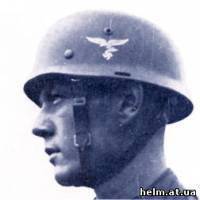

M36 helmet
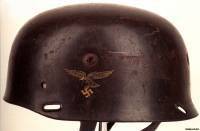
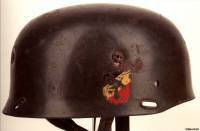
M36 helmet with upgraded balaclava from M38
Often there is an opinion that parachute helmets of models М36, М37 were made by cutting the fields of standard helmet М35. Most likely, this misconception was promoted by a not very accurate translation (or an incorrect understanding of the translation) from foreign sources in which the general form with the M35 helmet is mentioned. For those who are at least a little familiar with press-forging production and industrial (serial) metalworking technology, such a question would never have stood. As you know, helmets were made by hot stamping from sheet metal and in the course of serial (even small-scale) production, not one and not two presses were used, and, accordingly, a separate die was installed on each of the presses. As they wear out, the die forms were regularly replaced with new ones, which were made according to unified drawings in the tool division of the enterprise, so it’s not worth talking about a single (single) form. You can only talk about the uniformity of forms, made on the basis of a common technical documentation, a single, standard sample.
Cutting the fields of a finished standard helmet as a separate, very laborious and completely unjustified technological operation seems to be completely devoid of any meaning. It is much easier and more technological to make an abbreviated, "cut-off" mold based on the standard version. Directly trimming the field of the helmet, you can imagine it is possible only at the development stage of the helmet, in the process of design and testing.
When developing a special parachute helmet, the changes also affected the construction of the balaclava, but only in terms of changing the chinstrap system. The fastening of the cap comforter to the helmet with the help of three buttons-clasps remained unchanged, but a thick layer of foamed rubber was added to the base of the cap comforter (helmet). Like M1935, the same hollow rivets for air valves were used in the helmet. A new belt system has been designed, therefore, to cross behind the back of the neck and down around the chin while crossing (crossing) on both sides of the ears. Four oblong slots were made to fasten the belts in the helmet.
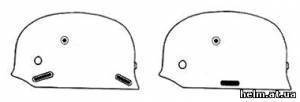
Differences МХNUMX and М36
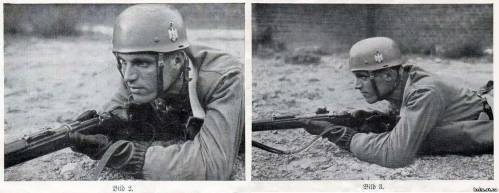
M37 helmet
In 1937, a new modification of the helmet appeared, which received the name M37. The helmet used the same components as the M1936 model, except that the new model had two, rather than four, slots for attaching belts. However, all designs based on the standard military model M35 were not sufficiently effective in the process of operation. The drawbacks were so obvious that it became necessary to develop a special helmet for parachutists, without using the basic army model and its components.
It should be noted that the helmets of models М36, М37 practically did not survive. All over the world there are only a few such products. All that appears on the market is a late rework from army-wide helmets, sometimes of very high quality.
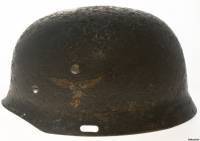
Original M37 helmet (military archeology)
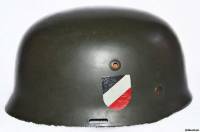
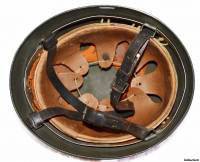
A fundamentally new helmet model specifically for parachutists was developed and introduced on June 16 1938 of the year and received the name M38. In addition to the original form of the helmet's sphere, the construction of the balaclava was completely redesigned, which was attached to the sphere with four bolts (two on the back of the helmet and two on the sides), the bolts themselves had through-vents and two recesses for a special key.
Over time, the fastening bolts were modified. The earliest examples of helmets were copper (brass) bolts, later they were made of steel, for convenience, a slot for a standard flathead screwdriver appeared on the bolt head. After some time, the bolt became aluminum. At the end of the war the vent hole in the bolt disappeared. After the appearance of the new model of parachute helmet, the previous versions were either withdrawn from the troops, or an upgraded liner was installed in them, which was fastened with bolts. According to the Luftwaffe instructions from 15 March 1938, the life of the helmet was limited to 15 for years. The liner was attached to the reinforced hoop new design. Initially, the hoop was made of aluminum, which was later replaced by galvanized steel.

Bolts and key for fastening the balaclava of model М38
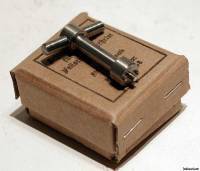
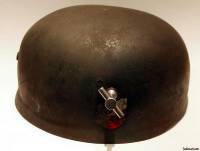
The cap comforter was made of two leather segments sewn centrally into a single sphere. For ventilation in the skin of the balaclava, twelve holes were made, which were evenly distributed over the entire surface of the sphere. Sheet foam rubber in the form of seven petals (strips) was used as a shock absorber between the hoop and the skin over the entire inner surface of the helmet. The exact individual fit of the helmet was carried out by changing the thickness of the rubber sheet.
The chinstrap of the helmet had a Y-shape and was mounted on the bolts of the liner fastening with the aid of holes with grommets. The length of the belt could be adjusted due to the presence of three holes in a row located at the ends of the belt.

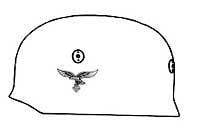
Helmet sample 1938 year. M38
The M38 helmets of the Heisler engineer were made only at one Eisenhuttenwerk facility at Thale, the leader of German industry in the manufacture and design of helmets, and were marked with ET or ckl marks respectively. In the production there were helmets 64, 66, 68, 71 sizes, and 64 size, unlike the army helmets, is extremely rare.
The early versions of helmets for parachutists had two decals - the national tricolor shield and the emblem of belonging to the class of troops Luftwaffe (Air Force) or Heer (ground forces). Later, on January 1, 1939, all parachute units were subordinated to a single command within the Luftwaffe structure and had only the air force emblem.
The first (early) pattern of the Luftwaffe decal was used from March 1 on March 1935 of the year, up to the introduction of the new sample, which was introduced at the end of 1936 or at the beginning of 1937 of the year. The instructions from 12 on June 1940 stopped using the national decal (tricolor), and further instructions from 28 on August 12 1943 canceled the decal with the image of an eagle and prescribed that the decals should be removed from all helmets in service, although the directives also as in case with army helmets, no one firmly adhered to.
Due to its anturability and a relatively small number of Germanic parachute helmets model M38, not to mention the earlier models (M36, M37), are often subject to alteration by "creative refinement" of conventional helmets.
The liner was attached to the reinforced hoop new design. Initially, the hoop was made of aluminum, which was later replaced by galvanized steel.
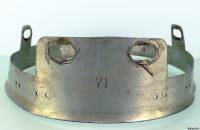
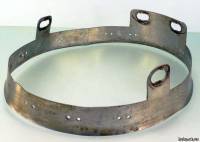
The cap comforter was made of two leather segments sewn centrally into a single sphere. For ventilation in the skin of the balaclava, twelve holes were made, which were evenly distributed over the entire surface of the sphere. Sheet foam rubber in the form of seven petals (bands) was used as a shock absorber, located between the hoop and the skin over the entire inner surface of the helmet. The exact individual fit of the helmet was carried out by changing the thickness of the rubber sheet.
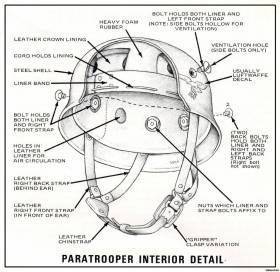
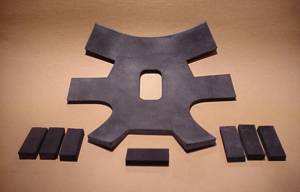
Rubber Shock Absorber (Replica)
The chinstrap of the helmet had a Y-shape and was mounted on the bolts of the liner fastening with the aid of holes with grommets. The length of the belt could be adjusted due to the presence of three holes in a row located at the ends of the belt.
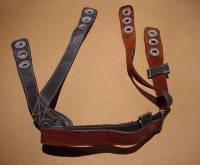
Chinstrap (replica)
After the appearance of the new model of parachute helmet, the previous versions were either withdrawn from the troops, or an upgraded liner was installed in them, which was fastened with bolts. According to the Luftwaffe instructions from 15 March 1938, the life of the helmet was limited to 15 for years.
The first pattern of the Luftwaffe decal eagle was used from 1 on March 1935 of the year, up to the introduction of the new model, which was introduced at the end of 1936 or at the beginning of 1937 of the year. The instructions from 12 on June 1940 stopped using the national decal (tricolor), and further instructions from 28 on August 12 1943 canceled the decal with the image of an eagle and ordered that the decals should be removed from all helmets in service, although the directives also as in the case of army helmets, no one firmly adhered.
Sources:
http://helm.at.ua/publ/stalnoj_shlem/germanija/fallschirmjager/5-1-0-29
http://battlefront.ru/stalhelm.htm
http://15061981.diary.ru/p200702695.htm?oam#more1
http://www.antik1941.ru/new_catalog/?mode=descr&cat_id=29&item_id=20785
https://historyporn.d3.ru/desantnyi-shlem-m38-567214/
Information